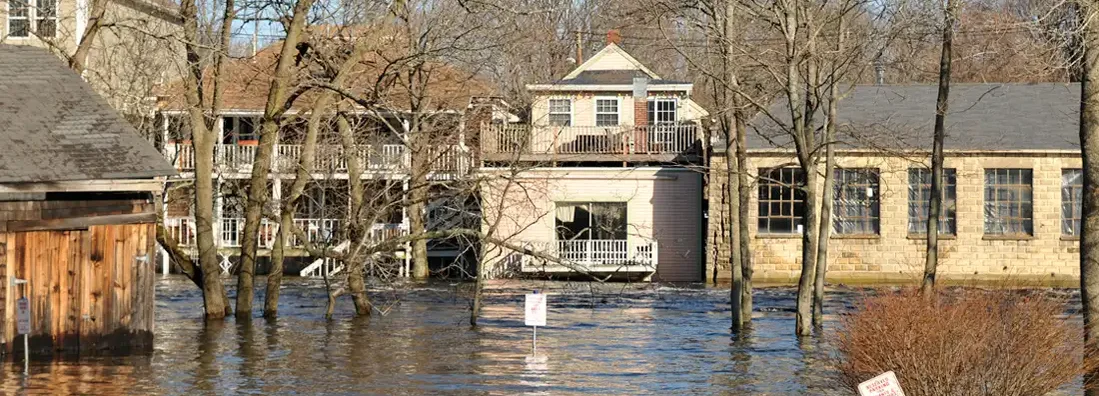Flood Insurance in Washington, DC
Experts break down flood insurance costs, coverage, companies, and more in Washington, DC.

Jeff Green has held a variety of sales and management roles at life insurance companies, Wall street firms, and distribution organizations over his 40-year career. He was previously Finra 7,24,66 registered and held life insurance licenses in multiple states. He is a graduate of Stony Brook University.

Nestled between the Potomac and Anacostia rivers on one side and the Patuxent River and Chesapeake Bay on the other, Washington, DC always has the potential for flooding. Washington’s location at the confluence of the Potomac and Anacostia rivers, combined with three buried waterways, broad floodplains, and relatively flat elevations, renders it highly susceptible to periodic flooding.
If you’re a homeowner in Washington, DC, it’s important to understand that your homeowners insurance does not cover flood damage. And you may actually reside in an area that is designated as a high-risk flood zone. You need flood insurance to make sure that your home and belongings are covered in the event of a damaging flood.
An independent insurance agent can help you learn more about flood insurance in Washington, DC.
What Is Flood Insurance?
Your Washington, DC homeowners insurance policy does not provide coverage for damage caused by flooding.
Congress created the National Flood Insurance Program (NFIP) in 1968 to help provide a way for property owners to financially protect themselves from flood damage. Flood insurance from the NFIP is available to homeowners, renters, condo owners, and business owners in communities that participate in the program.
Your NFIP flood insurance policy only covers your property damage under certain conditions. The NFIP defines a flood as “An excess of water on land that is normally dry, affecting two or more acres of land or two or more properties.”
Other examples of flooding as defined by the NFIP include:
- Overflow: During a tropical storm or a hurricane, storm surge can cause an overflow of inland or tidal waters.
- Runoff: When an area without sufficient drainage receives heavy rainfall in a short period of time.
- Mudflow: Heavy or sustained rainfall accumulates on the ground and forms a river of mud down a hillside. This is a common occurrence after a wildfire.
- Erosion: Severe storms can produce waves and cause shoreline erosion along lakes and other bodies of water.
Not every homeowner in Washington, DC needs to buy flood insurance. But your mortgage lender might require flood insurance if you live in a high-risk flood zone. This is important to understand, because several areas in Washington, DC are highly susceptible to flooding.
What Does Flood Insurance Cover in Washington, DC?
According to FloodSmart.gov, flood insurance policies cover physical damage to your property and possessions, including the following:
Building coverage
- The insured building and its foundation
- Electrical and plumbing systems
- Central air conditioning equipment, furnaces, and water heaters
- Refrigerators, cooking stoves, and built-in appliances
- Permanently installed carpeting over unfinished flooring
- Permanently installed paneling, wallboard, bookcases, and cabinets
- Window blinds
- Detached garages
- Debris removal
Contents coverage
- Clothing, furniture, and electronic equipment
- Curtains
- Portable and window air conditioners
- Portable microwave ovens and portable dishwashers
- Carpets that are not included in building coverage
- Clothes washers and dryer
- Food freezers and the food in them
- Certain valuable items such as original artwork and furs, up to $2,500
Building coverage and contents coverage must be purchased separately, and always have separate deductibles. If you do not purchase contents coverage, your flood-damaged personal property will not be covered.
Certain items or types of damage are not covered by flood insurance in Washington, DC, including:
- Damage caused by moisture, mildew, or mold that could have been avoided by the property owner
- Currency, precious metals, and valuable papers such as stock certificates
- Property and belongings outside of an insured building such as trees, plants, wells, septic systems, walks, decks, patios, fences, seawalls, hot tubs, and swimming pools
- Living expenses such as temporary housing
- Financial losses caused by business interruption or loss of use of the insured property
- Cars and other vehicles, and their parts
In addition to these exclusions, coverage for basements and areas below the lowest elevated floor is limited. These exclusions may apply to basements, crawl spaces, walkout basements, and enclosed areas under certain types of elevated buildings.
You will need to talk with your independent insurance agent about the specifics of your basement coverage. It may depend on the date of construction and where your home is located.
Do You Need Flood Insurance in Washington DC?
Every home or neighborhood has at least some flood risk. It’s important to know whether you live in a high-risk, low-risk, or moderate-risk flood area.
The easiest way to find out if your home is located in a flood zone is to visit the website of the National Flood Insurance Program, FloodSmart.gov. The Flood Map Service Center provides flood maps for communities across the US.
Flood maps depict a community’s flood risk, including the flood zones, floodplain boundaries, and base flood elevation. These can help you determine your flood insurance requirements and get an idea of how much a flood insurance policy might cost.
Remember that while flood insurance isn't required by the District of Columbia, your mortgage lender is likely to require it if you live in a high-risk flood zone.
One of the greatest myths about flood insurance is that if you don’t live in a flood zone, you don’t need it. But the NFIP offers some startling statistics that might just make you think otherwise.
First, the NFIP stresses that policyholders outside high-risk flood areas file over 40% of all NFIP flood insurance claims and require one-third of federal disaster assistance for flooding. What’s more, disaster assistance is usually in the form of a loan that must be paid back, with interest.
What Flood Zones Require Flood Insurance in Washington, DC?
Washington, DC has a long history of flooding, with riverine flooding, tidal/coastal storm surges, and interior flooding as the three main causes. Washington experienced major riverine floods in 1936, 1937, and 1942. And there were two major riverine flooding events in 1996. Major tidal floods occurred in 1933, 1972 (Hurricane Agnes), and 2003 (Hurricane Isabel). As recently as 2006 and 2012 there were two major interior flooding events that impacted Federal Triangle, and the Bloomingdale and LeDroit Park neighborhoods, respectively.
Today there are 9,004 properties in Washington, DC that have greater than a 26% chance of being severely affected by flooding over the next 30 years. This represents 10% of all properties in the city.
While most of the Washington metro area is considered to be in a low- to moderate-risk flood zone, most of the land directly adjacent to the Potomac and Anacostia rivers is designated as a high-risk flood area, where flood insurance would be required for homeowners. Even some of the land surrounding the National Mall has been designated a high-risk flood area.
Others areas around the rivers are designated by the letter X, which means that while there is a high flood risk, it has been mitigated by a levee or some other accredited flood control measure.
With the "Using FEMA’s Flood Map Service Center" at https://msc.fema.gov/portal/home, you can find out if your home or business is in a flood zone by simply entering your exact address into the online map tool.
Here’s how to evaluate your flood risk based on the flood maps.
Low-risk flood areas: Zones X, B, C
- 26% of flood claims occur in these zones.
- Flood insurance is not required.
- Flood insurance is less expensive.
High-risk flood areas: Zones A, V
- 74% of flood claims occur in these zones.
- Flood insurance is required by your mortgage lender.
- Flood insurance is more expensive.
An independent insurance agent can help you understand the flood maps, and help you understand whether you need flood insurance in Washington, DC.
How Much Does Flood Insurance Cost in Washington, DC?
National Flood Insurance Program (NFIP) flood insurance rates do not differ from company to company or agent to agent. All policies include the same basic fees, and the average policy costs about $700 per year.
What you pay for flood insurance in Washington, DC will vary based on several factors, including:
- Age, size, and type of home construction
- Flood risk for your home’s location
- Elevation of the lowest floor of your home
And of course the deductible and amount of building and contents coverage that you need will impact the cost of flood insurance in Washington, DC.
Is Flood Insurance Expensive in Washington, DC?
The flood risk for your Washington, DC home is the biggest factor impacting how much your flood insurance policy will cost. Using the NFIP’s flood maps can help you determine how much you might pay for flood insurance in the District of Columbia.
If your home is in one of the high-risk flood areas, you can expect your flood insurance in Washington, D., to be expensive relative to a home in a low- to moderate-risk area.
What’s more, those who live in low- to moderate-risk areas may be eligible for a Preferred Risk Policy, which can be very affordable and will provide both building and contents coverage. The annual premium for a Preferred Risk Flood Insurance Policy is likely to be far less than the cost of making repairs on your own, or paying back a federal disaster loan.
What Are the Best Flood Insurance Companies in Washington, DC?
Flood insurance is typically purchased from the NFIP with the help of a local independent insurance agent, who can help you find the best flood insurance companies in Washington, DC.
Independent insurance agents make shopping for flood insurance easy. They can obtain quotes from the NFIP, and they may even be able to find a few private insurance companies that offer it. Your agent can make sure that you’re getting the best coverage and price for your needs.
Why Shop Flood Insurance with a Washington, DC Independent Insurance Agent?
Instead of getting an online quote, find an independent insurance agent now, and get one-on-one consultation and affordable options for the best coverage for your unique needs. Your agent will work with you free of charge, offering you a variety of options so you can make the best choice.
What’s more, your agent will be there for you when claim time comes. They know the ins and outs of the process and will make sure your claim is handled appropriately.
Contact an agent today for a free, no-obligation consultation.
https://floodfactor.com/city/washington-districtofcolumbia/1150000_fsid
https://www.floodsmart.gov/understanding-my-flood-zone
https://doee.dc.gov/service/flooding
https://www.floodsmart.gov/why-buy-flood-insurance
